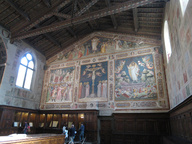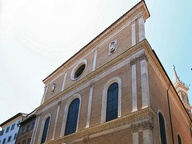Elmgreen & Dragset. Useless Bodies?
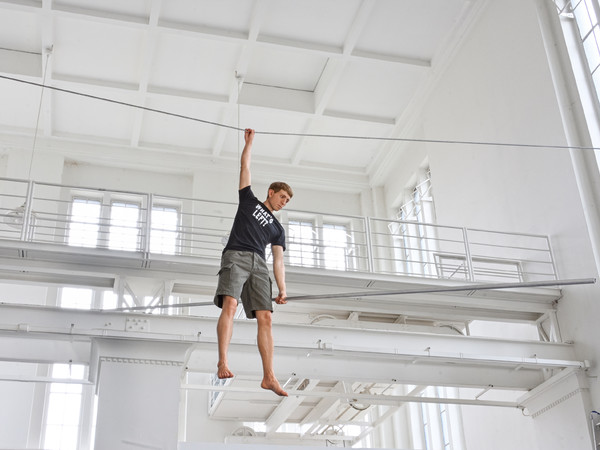
© Elmgreen & Dragset | Elmgreen & Dragset, What’s Left?, 2021. Silicone, clothing, wire rope, balancing pole. Dimensions variable I Ph. Elmar Vestner
From 31 Marzo 2022 to 22 Agosto 2022
Milan
Place: Fondazione Prada
Address: Largo Isarco 2
Official site: http://fondazioneprada.org
Fondazione Prada presents “Useless Bodies?”, an exhibition by the artist duo Elmgreen & Dragset taking place in Milan from 31 March to 22 August 2022 (Press Preview on 30 March).
Spanning more than 3,000 square meters, “Useless Bodies?” is one of the most ambitious thematic investigations realized by Fondazione Prada to date. Conceived for four gallery spaces and the courtyard of its Milan venue, the exhibition explores the present condition of the body in the post-industrial age in which it seems that our physical presence is losing its centrality or is even completely superfluous. This shift impacts every aspect of our lives: from our working conditions to our health, our interpersonal relationships, and the way we retain information. The exhibition “Useless Bodies?” also explores how we physically adapt to a world increasingly based on two-dimensional imagery, not least in the light of the current pandemic.
As stated by Elmgreen & Dragset, “our bodies are no longer the main agents of our existence. They don’t generate value in our societies’ advanced production methods as they did in the industrial era. One could claim our physical selves have even become more of an obstacle than an advantage. In the 19th century, the body was the producer of daily goods, whereas, in the 20th century, the body’s role became more that of the consumer. Twenty years into the 21st century the status of the body is now that of the product – with our data gathered and sold by Big Tech. With the publicly available knowledge surrounding the harvesting of data from tech companies being so inane, and the rapidly accelerating rate at which such companies are expanding into every aspect of our lives, it does sometimes feel a little scary to think about our bodies’ future role.”
Perception of the body is an underlying theme that connects many aspects of the sculptural and performative work of Elmgreen & Dragset, who throughout their career have explored subjects such as growing up, intimacy, identity, different modes of living and how we navigate the public sphere.
Following the exhibition path from the Podium, to the Nord gallery, to the Cisterna, the audience will encounter several immersive installations. The Milan premises of Fondazione Prada are transformed into a series of different universes, each with its own atmosphere, theme, and aesthetic.
On the ground floor of the Podium, classical and neoclassical sculptures meet works by Elmgreen & Dragset in a synchronic constellation. Inspired by Fondazione Prada’s inaugural exhibition “Serial Classic,” curated by Salvatore Settis and designed by Rem Koolhaas in 2015, this juxtaposition of contemporary and historic sculptures shows both similarities and differences in how artists have mediated the male body through sculptural practices spanning centuries. In this section the artists have developed a complex system of cross-references creating a dialogue between old and new that demonstrates that, “the past is never dead. It is actually never past,” as stated by the American writer William Faulkner. The second floor of Podium is transformed into a vast, abandoned office landscape which focuses on the changed role of the body in the context of labor. The installation consists of a repetitive pattern of seemingly endless rows of workstations, referencing the geometric formats of 20th century minimal sculpture. This environment also evokes dystopian movie sets from films such as Jacques Tati’s Playtime (1967) and Terry Gilliam’s Brazil (1985).
In the Nord gallery, the audience enters a futuristic vision of a domestic setting—an eerie fusion of a bunker, a spaceship, and a science lab, portraying an unlivable home of extreme vanity. The immaculate, dehumanized appearance of this space, emphasized by clinically designed objects, raises questions about how we exist in our homes today, especially now that we share them with technology to such a high degree. Like a detective or an uninvited guest, the visitor is free to wander the space, gather clues, and make up stories in an alienating environment, similar to a sci-fi movie set in which the only moving presence is that of a robotic dog.
In the Cisterna, the artists look into how the wellness, leisure, and health industries pressure us to conform to new body ideals. The three rooms of this building are turned into a forsaken spa-like environment, including an abandoned swimming pool and a locker room. As our bodies are being rendered useless by technological innovations, the ever-expanding wellness, leisure, and health sectors are offering countless new ways to “solve the problem of the imperfect body”. The central room of the Cisterna features a new work titled What’s Left?, which can be interpreted as a representation of the body that today struggles to find its role as a political actor or instrument of social change.
The way our bodies are physically regulated in the public sphere is explored by a number of sculptures by Elmgreen & Dragset presented in the outdoor spaces of Fondazione Prada. These works are subtle alterations of everyday objects, none of which can be used as we would expect them to be. They encourage a re-evaluation of the ordinary and highlight how we negotiate the control mechanisms embedded in public spaces.
A 500-page publication, titled “Useless Bodies?” and published by Fondazione Prada, is conceived as a thematic extension of the exhibition rather than a conventional catalogue. It is a reader with multiple perspectives from over 35 authors —philosophers, artists, writers, scientists, and thinkers— addressing our changing perceptions of the body and its status today.
Elmgreen & Dragset – Biographical note
Michael Elmgreen (born 1961 in Copenhagen, Denmark) and Ingar Dragset (born 1969 in Trondheim, Norway) are based in Berlin and have worked together as an artist duo since 1995.
They have held numerous solo exhibitions at art institutions worldwide, including EMMA – Espoo Museum of Modern Art, Espoo (2020); The Nasher Sculpture Center, Dallas (2019- 20); The Whitechapel Gallery, London (2018–2019); Tel Aviv Museum of Art (2016); UCCA, Beijing (2016); PLATEAU, Samsung Museum of Art, Seoul (2015); Astrup Fearnley Museet, Oslo (2014); Victoria and Albert Museum, London (2013–14); Museum Boijmans Van Beuningen, Rotterdam (2011); ZKM Museum of Modern Art, Karlsruhe (2010); Museo de Arte Contemporáneo de Castilla y León (2009); Serpentine Gallery, London (2006); Tate Modern, London (2004); and Kunsthalle Zürich (2001).
Their work has been included in the Bangkok (2018), Istanbul (2013, 2011, 2001), Liverpool (2012), Singapore (2011), Moscow (2011, 2007), Venice (2009, 2003), Gwangju (2006, 2002), São Paulo (2002), and Berlin (1998) biennials, and in 2009 they received a special mention for their exhibition “The Collectors” in the Nordic and Danish Pavilions at the 53rd Venice Biennale. Elmgreen & Dragset curated the 15th Istanbul Biennial in 2017.
The artists were shortlisted for the Hugo Boss Prize, Guggenheim Museum, New York (2000) and won the Preis der Nationalgalerie, Hamburger Bahnhof, Berlin (2002). In 2012 Elmgreen & Dragset were selected for London’s Fourth Plinth Commission in Trafalgar Square. In 2015 the artists received honorary doctorates at the Norwegian University of Science and Technology and in 2020 they were awarded the B.Z.-Kulturpreis in Berlin. In 2021, Elmgreen & Dragset were awarded the 14th Robert Jacobsen Prize of the Würth Foundation, Künzelsau, Germany.
Spanning more than 3,000 square meters, “Useless Bodies?” is one of the most ambitious thematic investigations realized by Fondazione Prada to date. Conceived for four gallery spaces and the courtyard of its Milan venue, the exhibition explores the present condition of the body in the post-industrial age in which it seems that our physical presence is losing its centrality or is even completely superfluous. This shift impacts every aspect of our lives: from our working conditions to our health, our interpersonal relationships, and the way we retain information. The exhibition “Useless Bodies?” also explores how we physically adapt to a world increasingly based on two-dimensional imagery, not least in the light of the current pandemic.
As stated by Elmgreen & Dragset, “our bodies are no longer the main agents of our existence. They don’t generate value in our societies’ advanced production methods as they did in the industrial era. One could claim our physical selves have even become more of an obstacle than an advantage. In the 19th century, the body was the producer of daily goods, whereas, in the 20th century, the body’s role became more that of the consumer. Twenty years into the 21st century the status of the body is now that of the product – with our data gathered and sold by Big Tech. With the publicly available knowledge surrounding the harvesting of data from tech companies being so inane, and the rapidly accelerating rate at which such companies are expanding into every aspect of our lives, it does sometimes feel a little scary to think about our bodies’ future role.”
Perception of the body is an underlying theme that connects many aspects of the sculptural and performative work of Elmgreen & Dragset, who throughout their career have explored subjects such as growing up, intimacy, identity, different modes of living and how we navigate the public sphere.
Following the exhibition path from the Podium, to the Nord gallery, to the Cisterna, the audience will encounter several immersive installations. The Milan premises of Fondazione Prada are transformed into a series of different universes, each with its own atmosphere, theme, and aesthetic.
On the ground floor of the Podium, classical and neoclassical sculptures meet works by Elmgreen & Dragset in a synchronic constellation. Inspired by Fondazione Prada’s inaugural exhibition “Serial Classic,” curated by Salvatore Settis and designed by Rem Koolhaas in 2015, this juxtaposition of contemporary and historic sculptures shows both similarities and differences in how artists have mediated the male body through sculptural practices spanning centuries. In this section the artists have developed a complex system of cross-references creating a dialogue between old and new that demonstrates that, “the past is never dead. It is actually never past,” as stated by the American writer William Faulkner. The second floor of Podium is transformed into a vast, abandoned office landscape which focuses on the changed role of the body in the context of labor. The installation consists of a repetitive pattern of seemingly endless rows of workstations, referencing the geometric formats of 20th century minimal sculpture. This environment also evokes dystopian movie sets from films such as Jacques Tati’s Playtime (1967) and Terry Gilliam’s Brazil (1985).
In the Nord gallery, the audience enters a futuristic vision of a domestic setting—an eerie fusion of a bunker, a spaceship, and a science lab, portraying an unlivable home of extreme vanity. The immaculate, dehumanized appearance of this space, emphasized by clinically designed objects, raises questions about how we exist in our homes today, especially now that we share them with technology to such a high degree. Like a detective or an uninvited guest, the visitor is free to wander the space, gather clues, and make up stories in an alienating environment, similar to a sci-fi movie set in which the only moving presence is that of a robotic dog.
In the Cisterna, the artists look into how the wellness, leisure, and health industries pressure us to conform to new body ideals. The three rooms of this building are turned into a forsaken spa-like environment, including an abandoned swimming pool and a locker room. As our bodies are being rendered useless by technological innovations, the ever-expanding wellness, leisure, and health sectors are offering countless new ways to “solve the problem of the imperfect body”. The central room of the Cisterna features a new work titled What’s Left?, which can be interpreted as a representation of the body that today struggles to find its role as a political actor or instrument of social change.
The way our bodies are physically regulated in the public sphere is explored by a number of sculptures by Elmgreen & Dragset presented in the outdoor spaces of Fondazione Prada. These works are subtle alterations of everyday objects, none of which can be used as we would expect them to be. They encourage a re-evaluation of the ordinary and highlight how we negotiate the control mechanisms embedded in public spaces.
A 500-page publication, titled “Useless Bodies?” and published by Fondazione Prada, is conceived as a thematic extension of the exhibition rather than a conventional catalogue. It is a reader with multiple perspectives from over 35 authors —philosophers, artists, writers, scientists, and thinkers— addressing our changing perceptions of the body and its status today.
Elmgreen & Dragset – Biographical note
Michael Elmgreen (born 1961 in Copenhagen, Denmark) and Ingar Dragset (born 1969 in Trondheim, Norway) are based in Berlin and have worked together as an artist duo since 1995.
They have held numerous solo exhibitions at art institutions worldwide, including EMMA – Espoo Museum of Modern Art, Espoo (2020); The Nasher Sculpture Center, Dallas (2019- 20); The Whitechapel Gallery, London (2018–2019); Tel Aviv Museum of Art (2016); UCCA, Beijing (2016); PLATEAU, Samsung Museum of Art, Seoul (2015); Astrup Fearnley Museet, Oslo (2014); Victoria and Albert Museum, London (2013–14); Museum Boijmans Van Beuningen, Rotterdam (2011); ZKM Museum of Modern Art, Karlsruhe (2010); Museo de Arte Contemporáneo de Castilla y León (2009); Serpentine Gallery, London (2006); Tate Modern, London (2004); and Kunsthalle Zürich (2001).
Their work has been included in the Bangkok (2018), Istanbul (2013, 2011, 2001), Liverpool (2012), Singapore (2011), Moscow (2011, 2007), Venice (2009, 2003), Gwangju (2006, 2002), São Paulo (2002), and Berlin (1998) biennials, and in 2009 they received a special mention for their exhibition “The Collectors” in the Nordic and Danish Pavilions at the 53rd Venice Biennale. Elmgreen & Dragset curated the 15th Istanbul Biennial in 2017.
The artists were shortlisted for the Hugo Boss Prize, Guggenheim Museum, New York (2000) and won the Preis der Nationalgalerie, Hamburger Bahnhof, Berlin (2002). In 2012 Elmgreen & Dragset were selected for London’s Fourth Plinth Commission in Trafalgar Square. In 2015 the artists received honorary doctorates at the Norwegian University of Science and Technology and in 2020 they were awarded the B.Z.-Kulturpreis in Berlin. In 2021, Elmgreen & Dragset were awarded the 14th Robert Jacobsen Prize of the Würth Foundation, Künzelsau, Germany.
SCARICA IL COMUNICATO IN PDF
COMMENTI

-
 Dal 31 gennaio 2024 al 04 maggio 2025
Fermo | Palazzo dei Priori
Dal 31 gennaio 2024 al 04 maggio 2025
Fermo | Palazzo dei Priori
-
 Dal 20 dicembre 2024 al 04 maggio 2025
Fermo | Palazzo dei Priori
Dal 20 dicembre 2024 al 04 maggio 2025
Fermo | Palazzo dei Priori
-
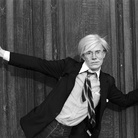 Dal 20 dicembre 2024 al 04 maggio 2024
Gorizia | Palazzo Attems Petzenstein
Dal 20 dicembre 2024 al 04 maggio 2024
Gorizia | Palazzo Attems Petzenstein
-
 Dal 18 dicembre 2024 al 18 dicembre 2024
Venezia | Museo Correr
Dal 18 dicembre 2024 al 18 dicembre 2024
Venezia | Museo Correr
-
 Dal 14 dicembre 2024 al 02 marzo 2025
Palermo | Palazzo Abatellis
Dal 14 dicembre 2024 al 02 marzo 2025
Palermo | Palazzo Abatellis
-
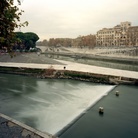 Dal 12 dicembre 2024 al 23 febbraio 2025
Roma | Palazzo Altemps
Dal 12 dicembre 2024 al 23 febbraio 2025
Roma | Palazzo Altemps

